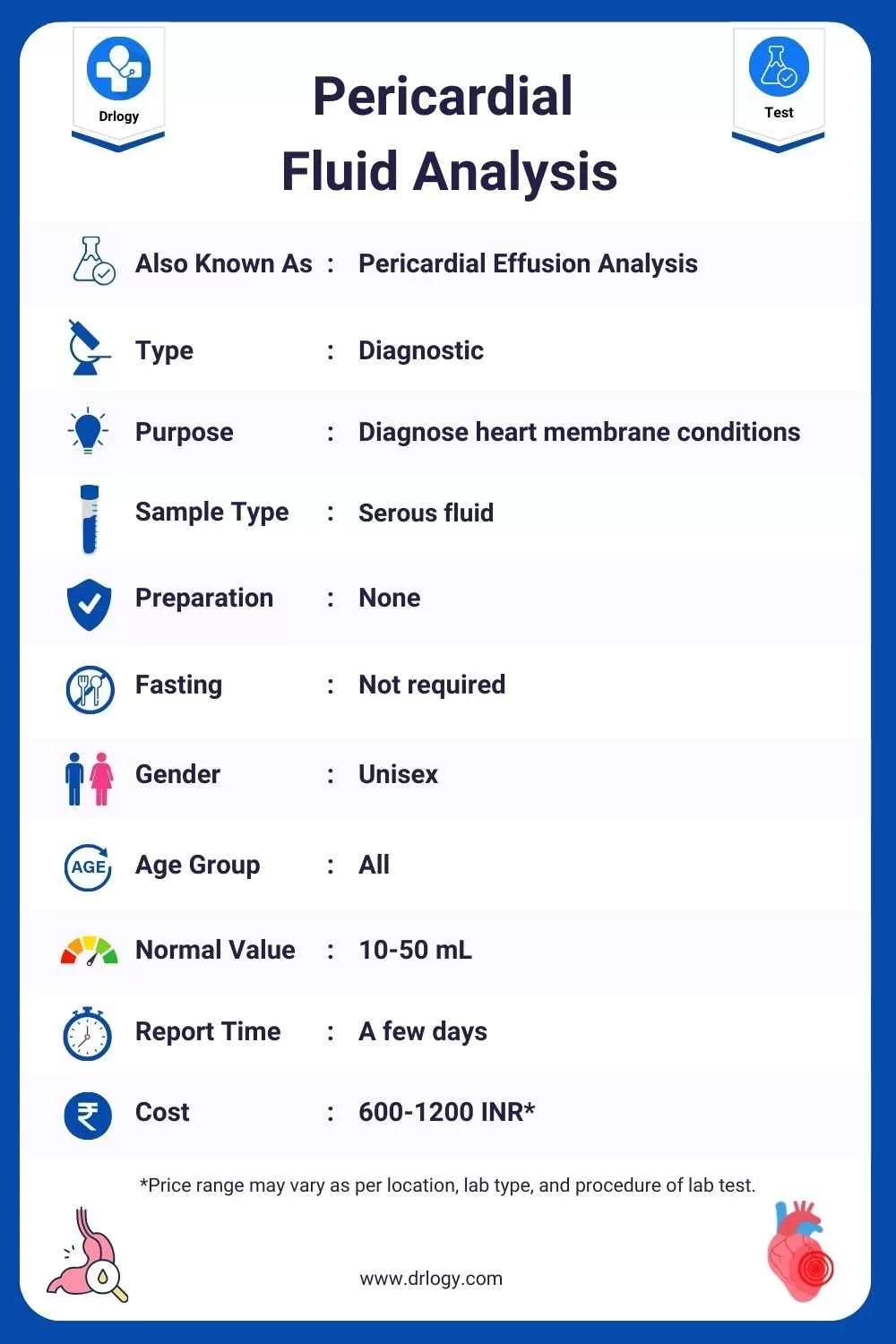
Pericardial Fluid Analysis is a medical test used to investigate heart membrane issues. It helps identify causes of heart inflammation and fluid buildup, guiding treatment decisions.
Here are the basic details of the Pericardial Fluid Analysis.
| Also Known As | Pericardial Effusion Analysis |
| Type | Diagnostic |
| Purpose | Diagnose heart membrane conditions |
| Sample Type | Serous fluid |
| Preparation | None |
| Fasting | Not required |
| Gender | Unisex |
| Age Group | All |
| Normal Value | 10-50 mL |
| Reporting Time | A few days |
| Cost | 600-1200 INR* |
*Pericardial Fluid Analysis Price range may vary as per location, lab type, and lab test procedure.
Pericardial Fluid Analysis is a diagnostic procedure used to evaluate fluid around the heart, assisting in the diagnosis of pericarditis and pericardial effusion.
The purpose of the Pericardial Fluid Analysis is to:

Here is the basic preparation for the Pericardial Fluid Analysis.
Here is the basic Pericardial Fluid Analysis Procedure.
Here is the basic reading of Pericardial Fluid Analysis results.
Here is the normal range of the Pericardial Fluid Analysis.
| Parameter | Normal Range |
|---|---|
| Fluid Volume | 10–50 milliliters (ml) |
Here is the Interpretation of the Pericardial Fluid Analysis.
| Parameter | Interpretation |
|---|---|
| Fluid Type | Transudate: heart failure, exudate: infection or inflammation, potentially cancer. |
| Protein or Albumin Level | High levels in exudate indicate inflammation or infection; low in transudate. |
| Cell Count (White Blood Cells) | Increased WBCs suggest infection or inflammation; lower count in transudate. |
| Cell Count (Red Blood Cells) | The presence of RBCs may indicate bleeding into the pericardial sac. |
| Glucose Level | Lower glucose in fluid compared to blood may suggest infection. |
| Appearance | Cloudy or bloody fluid may imply microorganisms or bleeding; clear: normal. |
Here are the potential causes of transudate Pericardial Fluid Analysis:
| Possible Causes | Description |
|---|---|
| Congestive Heart Failure | Increased pressure forces fluid out of blood vessels. |
| Cirrhosis | Liver disease results in low blood protein levels. |
| Hypoalbuminemia | Low blood albumin levels reduce fluid retention capacity. |
| Nephrotic Syndrome | Kidney disease leads to protein loss, causing fluid shift. |
Pericardial fluid analysis helps diagnose heart membrane conditions by evaluating fluid composition, distinguishing transudate and exudate types for tailored treatment.
Here are the potential causes of exudate Pericardial Fluid Analysis levels:
| Possible Causes | Description |
|---|---|
| Infections | Viral, bacterial, or fungal infections can trigger inflammation and fluid accumulation. |
| Inflammatory Conditions | Conditions like rheumatoid arthritis, lupus, or post-heart attack inflammation. |
| Malignancies | Mesothelioma, metastatic cancer, or lymphoma. |
| Bleeding | Bleeding disorders or trauma can lead to blood in pericardial fluid. |
Here are the specimen requirements for the Pericardial Fluid Analysis.
|
Specimen |
Serous fluid |
|
|
Volume |
1 to 2 mL |
|
|
Container |
Lavender-top tube or green-top tube |
|
|
Collection |
Follow standard collection with heparin in the syringe to prevent clotting. |
|
|
Storage |
Refrigerate |
|
|
Sample Stability |
Temperature |
Period |
|
Room temperature |
Unstable |
|
|
Refrigerated |
2 days |
|
|
Frozen |
Unstable |
|
|
Freeze/thaw cycles |
Unstable |
|
|
Causes for Rejection |
Room temperature storage; frozen specimen; improperly labeled specimen; quantity not sufficient for analysis; gel-barrier tube |
|
This analysis is generally safe when performed by skilled healthcare professionals.
Here is the basic limitation of the Pericardial Fluid Analysis.
Here are some of the risk factors of the Pericardial Fluid Analysis.
Here are the Doctor's recommendations or consult a specialist after the Pericardial Fluid Analysis.
| Doctor to Visit | Reason for Visit | Comments |
|---|---|---|
| Cardiologist | Transudate and Exudate | For heart-related evaluation. |
| Pulmonologist | Respiratory Symptoms | For lung-related concerns. |
| Oncologist | Malignancy Suspected | To investigate cancer potential. |
Here are the estimated Pericardial Fluid Analysis Prices in India with different top cities:
|
City |
Price Range (INR)* |
|
600-1200 |
|
|
600-1200 |
|
|
600-1200 |
|
|
600-1200 |
|
|
600-1200 |
|
|
600-1200 |
|
|
600-1200 |
|
|
600-1200 |
|
|
600-1200 |
|
|
600-1200 |
|
|
600-1200 |
|
|
600-1200 |
|
|
600-1200 |
|
|
600-1200 |
*Pericardial Fluid Analysis Prices are approximate and vary depending on a specific laboratory or healthcare facility.
Summary
Overall, Pericardial Fluid Analysis diagnoses heart membrane issues by evaluating fluid composition, helping differentiate transudate and exudate for tailored treatment. Also check Drlogy Test for detailed information about all medical tests for patients, doctors, scholers and medical students.
Reference
DOCTOR'S MOST TRUSTED HEALTHCARE PLATFORM
10M+Patients
30000+Doctors
25000+Hospitals/Labs